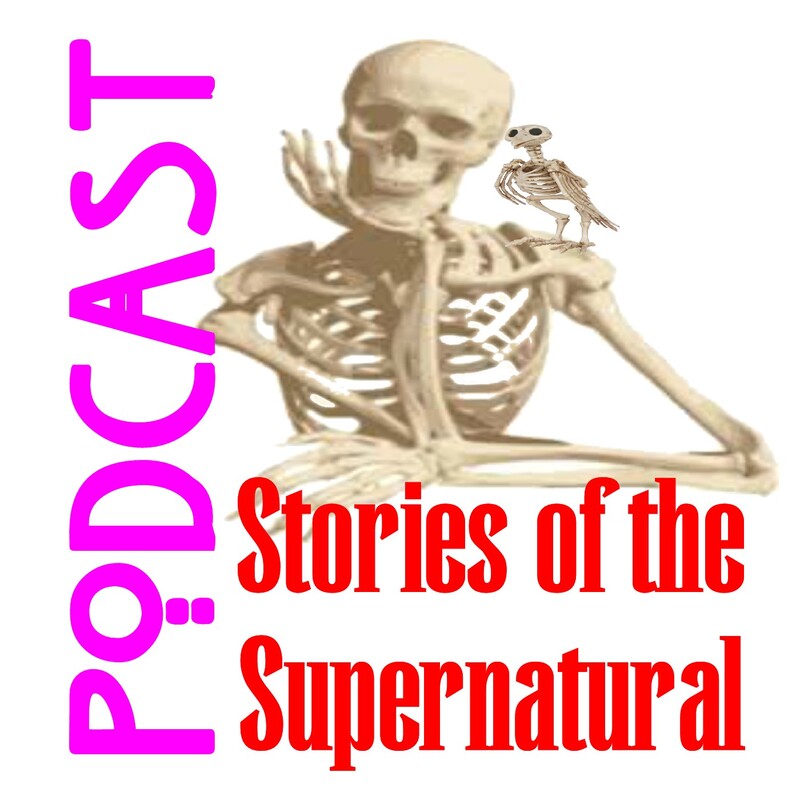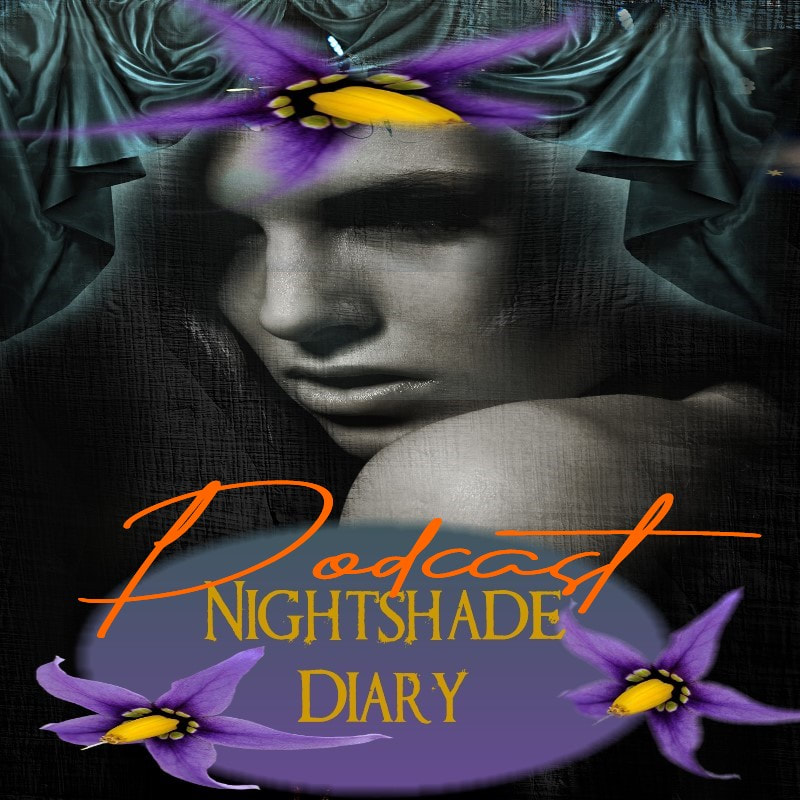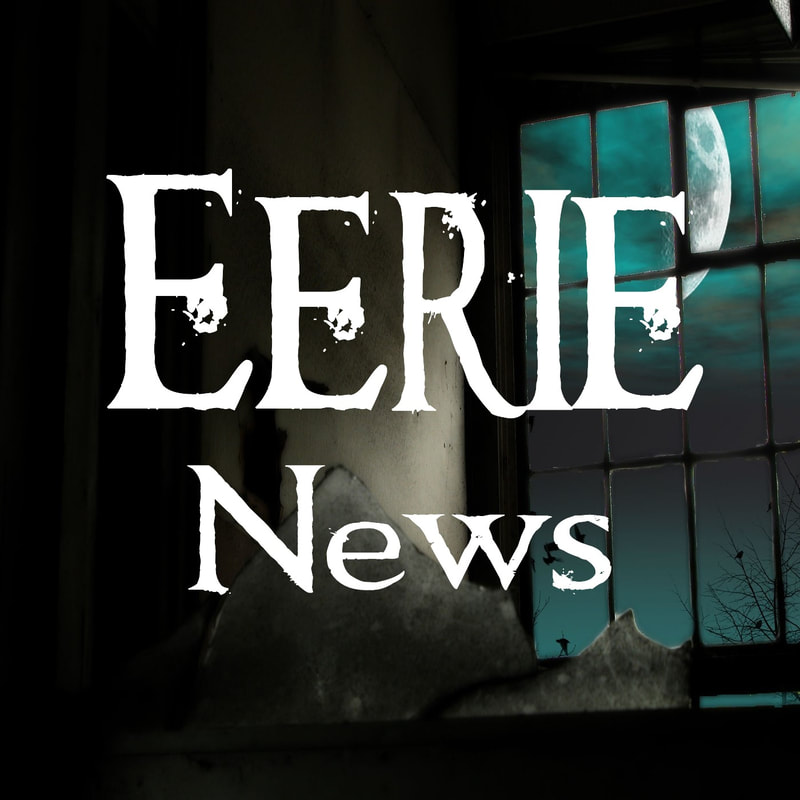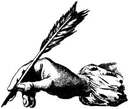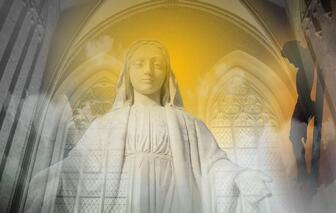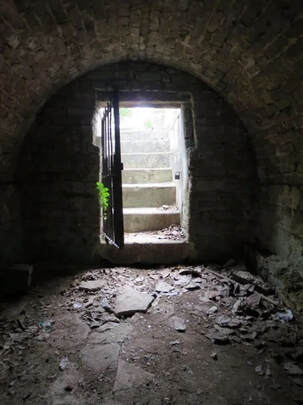
By M.P. Pellicer | Stranger Than Fiction Stories
Barbados' Christ Church Cemetery has been in existence for well over 200 years, but besides the obvious, which is that all its occupants are deceased, there was one family crypt that for many years suffered from unexplained events that even brought the governor of the island to the cemetery to get to the bottom of the mystery. 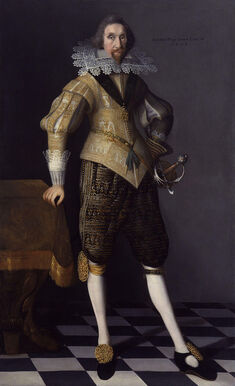 James Hay, 1st Earl of Carlisle, made Lord Proprietor of Barbadoes by King Charles I on July 2, 1627 James Hay, 1st Earl of Carlisle, made Lord Proprietor of Barbadoes by King Charles I on July 2, 1627
Barbados is an island in the Lesser Antilles, and known as a tourist destination. Most are not aware of the mysterious events that took place in Christ Church Cemetery between 1808 and 1819. In those years it was part of the British Empire, and the industries of tobacco, sugar and cotton flourished.
The first Christ Church was built in 1629, but high tides destroyed it 40 years later. It wasn't until 1780 that a new structure was built further inland, next to an old cemetery, which already held the Elliot Crypt, later to become the Chase Vault. At that time it was unused. The church would go on to be rebuilt three times due to fire and hurricanes. The cemetery was an ancient colonial one that overlooked Oistins Bay. The crypt was constructed of coral rock, built 12 feet deep with an arched roof, six feet wide and stairs that led down to the main entrance. Humphrey Waldrond born at sea came to the West Indies during the 15th century and served as Deputy Governor (1660-1663), his family along with the Elliots operated large plantations. It's not certain which of the two families ordered the vault to be built, but considering they were related by marriage it's possible they corroborated on the construction. 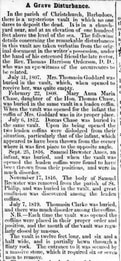 An account of the disturbances in the Christ Church Cemetery c.1865 An account of the disturbances in the Christ Church Cemetery c.1865
James Elliot (1690-1724) died as a young man, but he was laid to rest outside the vault. His is one of the oldest memorials which reads: "Here lies the body of the hon'ble James Elliot Esq'r, Son the Hon'ble Richard Elliot Esq'r. He maryed Elizabeth the daughter of the Hon'ble Thomas Walrond, Esq'r of this island... "
Elizabeth followed her husband to the grave eight years later to the day, and hers was the first coffin to be placed inside the vault. However it wasn't until the death of Thomasina Goddard, a relative who was buried on July 31, 1807, that the first mystery of the vault came to light. Elizabeth Elliot's coffin which had been left inside in 1792 was missing, and no one could explain how this had occurred. 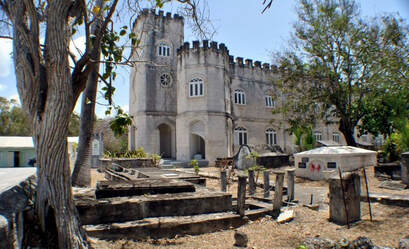 Christ Church cemetery c.2016 Christ Church cemetery c.2016
Whatever the conjecture was at that time, Thomasina's simple wooden coffin was left inside the chamber. The entrance was sealed with a blue marble slab that weighed about 1,000 pounds and required several men to move it.
The Chase family bought the crypt in 1808 to bury their 2-year-old daughter Mary Ann Maria Chase who died on February 22nd. Four years later, another daughter Dorcas died when she was 12 years old. The circumstances were mysterious, and rumors swirled that she starved herself to death due to her father's abusive temper. The patriarch Colonel Thomas Chase, was known to be a cruel man who did not spare neither his family or his slaves. Upon opening the vault on July 6, 1812 they found Mary Ann's coffin in the opposite corner and turned upside down. The coffins belonging to Thomasina Goddard and Mary Ann Chase were returned to their original location. Dorcas' coffin was placed inside. A month after Dorcas' death, the slab to the vault was slid away, this time to receive the body of her father Colonel Thomas Chase, who was said to have committed suicide. Like his daughters he was buried in a lead coffin that required eight men to carry it in. Again the coffins were found far away from where they had been left at. 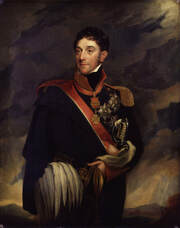 Lord Combermere, then governor of Barbados made an effort to solve the mystery of the moving coffins Lord Combermere, then governor of Barbados made an effort to solve the mystery of the moving coffins
Four years would pass until the slab was removed on September 25, 1816, to receive the infant Samuel Brewster Ames, who was a Chase relative. The unexplainable had happened again in regards to the coffins.
Two months later, Samuel Brewster Ames Sr. was disinterred from the cemetery of St. Philip and buried in the vault. He had been killed by his slaves during a bloody revolt in April, 1816 on Easter Sunday. Thirty plantations were burned down during this event. Like the previous times, the leaden coffins had been thrown around inside the chamber, and Thomasina Goddard's wooden casket was so disintegrated it had to be held together by ropes. Rev. Thomas Orderson (1769-1833) was on hand for the opening of the vault. He inspected the walls, ceiling and floor for cracks. He searched for a secret entrance, and nothing was found to account for how access was gained. Rev. Orderson, a native of Barbados acted as Rector of the Protestant Episcopal Church, in the parish of Christ Church for 30 years. Vandals were blamed, but nothing had ever been stolen or the caskets breached. The slab was checked, and it did not appear to have been moved since the last interment. An earthquake, like the other explanations was dismissed since nothing around the graveyard had been disturbed. 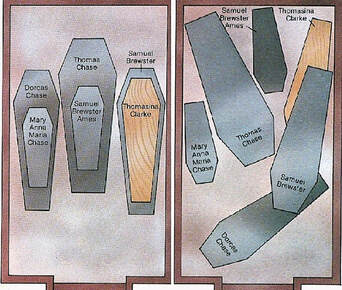 Chase Vault diagram, Barbados Chase Vault diagram, Barbados
Mrs. Goddard's coffin was placed between Samuel Brewster's coffin and the wall. The coffins were placed three on the ground, side by side and the other laid on top of them. The door was sealed with mortar.
The natives of the island blamed it on supernatural causes, black magic and duppies. They claimed that due to Colonel Chase's cruelty and the death of his daughter, none of the dead could endure the company of the Chases in their final resting place. No one would approach the churchyard after nightfall. In 1819, the crypt was opened for the burial of Thomasina Clark in a simple wooden coffin. Again the coffins were moved, with the heaviest ones slung around. The phenomena caught the attention of the governor of Barbados at the time, Lord Combermere, who had been present at Clark’s funeral and had witnessed the bizarre occurrence for himself. He ordered a thorough and extensive inspection of the tomb to look for any evidence to explain the strange happenings. A layer of sand was spread on the floor to expose the footprint of anyone breaking in. The governor’s wife explained the investigation thus: “In my husband’s presence, every part of the floor was sounded to ascertain that no subterranean passage or entrance was concealed. It was found to be perfectly firm and solid; no crack was even apparent. The walls, when examined, proved to be perfectly secure. No fracture was visible, and the sides, together with the roof and flooring, presented a structure so solid as if formed of entire slabs of stone. The displaced coffins were rearranged, the new tenant of that dreary abode was deposited, and when the mourners retired with the funeral procession, the floor was sanded with fine white sand in the presence of Lord Combermere and the assembled crowd. The door was slid into its wonted position and, with the utmost care, the new mortar was laid on so as to secure it. When the masons had completed their task, the Governour made several impressions in the mixture with his own seal, and many of those attending added various private marks in the wet mortar…” 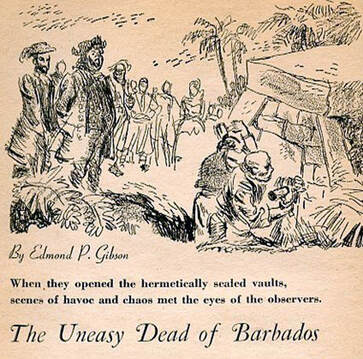 The Uneasy Dead of Barbados The Uneasy Dead of Barbados
It was inevitable that stories of phantoms would circulate. One such story goes that a woman on horseback heard menacing shrieks and groans emanating from the tomb as she passed it. Her horse went into a berserk panic, foaming at the mouth and threatening to throw the woman off. It was then reported that several other horses in the nearby village became insane in the ensuing days and mindlessly dove into the bay, where they drowned.
With the revolt from April, 1816, still fresh in the minds of the English landowners the baffled populace again looked at the slaves suspiciously, even though such accusations were difficult to justify. The slaves stayed away from the cemetery completely, fearing the work of malevolent “duppies”. If asked by curiosity seekers where the vault was, many would pretend not to know anything about it at all. A feeling of dread fell over the islanders. The Chase family realized they could only resolve the problem by moving the coffins, which. They were buried in secret somewhere in the cemetery. The vault was closed, never to be used again. In 1907, Andrew Lang a folklorist published his findings concerning research on the case of the moving coffins in Folk-Lore: A Quarterly Review on Myth, Tradition, Institution & Custom. He had found reference to the incident in Captain James Alexander's book Transatlantic Sketches (1833). The death and burials were recorded in the Book of Christ Church. An account of the strange occurrences was included by Sir Stapleton Cotton in his Memoirs and Letters of Lord Combermere (1868). Lord Combermere's son, the 2nd Viscount Combermere would be subject of conjecture concerning the afterlife since a famous photograph was circulated of him sitting in his favorite chair in Combermere Abbey after he had died
0 Comments
Your comment will be posted after it is approved.
Leave a Reply. |
Stranger Than Fiction StoriesM.P. PellicerAuthor, Narrator and Producer Archives
July 2024
Categories
All
|
Stories of the Supernatural
- Stories of the Supernatural
- Miami Ghost Chronicles
- M.P. Pellicer | Author
- Stranger Than Fiction Stories
- Eerie News
- Supernatural Storytime
-
Astrology Today
- Tarot
- Horoscope
- Zodiac
-
Haunted Places
- Animal Hauntings
- Belleview Biltmore Hotel
- Bobby Mackey's Honky Tonk
- Brookdale Lodge
- Chacachacare Island
- Coral Castle
- Drayton Hall Plantation
- Jonathan Dickinson State Park
- Kreischer Mansion
- Miami Biltmore Hotel
- Miami Forgotten Properties
- Myrtles Plantation
- Pinewood Cemetery
- Rolling Hills Asylum
- St. Ann's Retreat
- Stranahan Cromartie House
- The Devil Tree
- Trans-Allegheny Lunatic Asylum
- West Virginia Penitentiary
- Paranormal Podcasts
"When misguided public opinion honors what is despicable and despises what is honorable, punishes virtue and rewards vice, encourages what is harmful and discourages what is useful, applauds falsehood and smothers truth under indifference or insult, a nation turns its back on progress and can be restored only by the terrible lessons of catastrophe."
- Frederic Bastiat
- Frederic Bastiat

Copyright © 2009-2024 Eleventh Hour LLC. All Rights Reserved ®
DISCLAIMER
DISCLAIMER
 RSS Feed
RSS Feed

